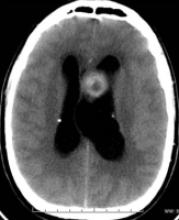Subependymal Giant Cell Astrocytoma in Tuberous Sclerosis
- Subependymal Giant Cell Astrocytoma (SEGA) is the most common cerebral neoplasm in TS, a disease that has an autosomal dominant pattern of inheritance in 20'50% of patients and the presence of tubers and subependymal glial nodules in 90'100%.
- SEGA is virtually always located near the foramina of Monro; symptoms relate to increased intracranial pressure and seizures.
- SEGA is characterized by slow growth and benign biologic behavior corresponding to WHO grade I.
- On CT, SEGA appears as an isoattenuated to slightly hypoattenuated mass near a foramen of Monro. Calcification is common. Hemorrhage within a SEGA may also occur.
- On MRI, SEGA usually manifests with T1 hypointensity compared to white matter and heterogeneous hyperintensity on T2 sequences.







